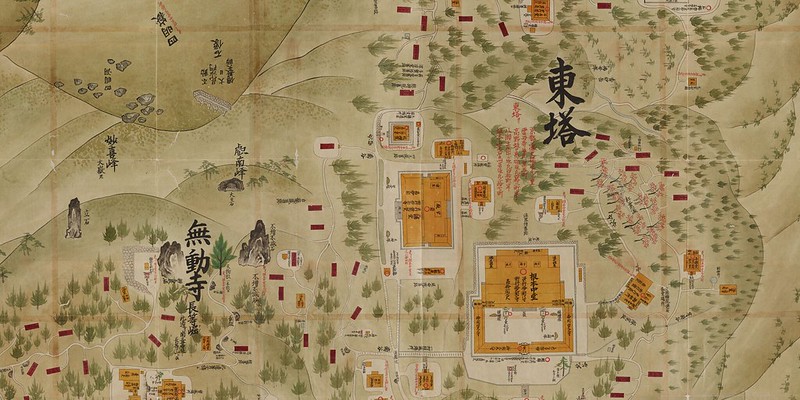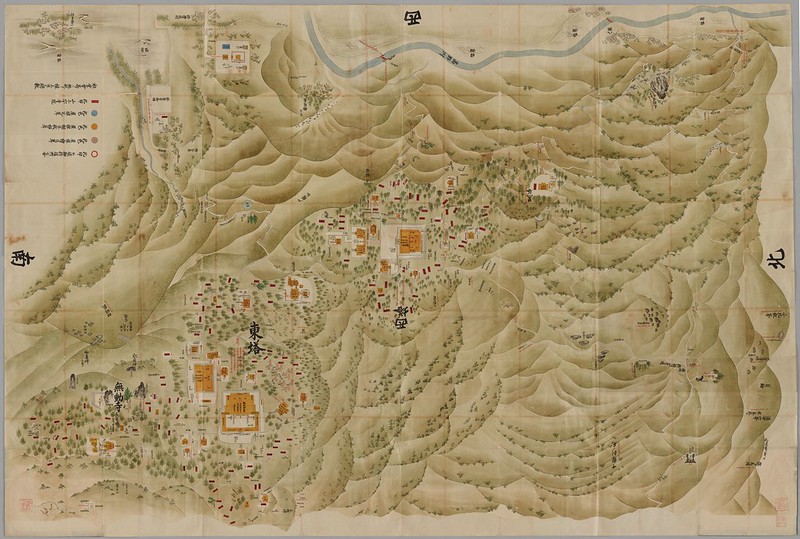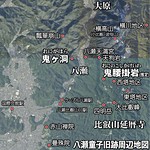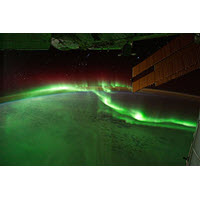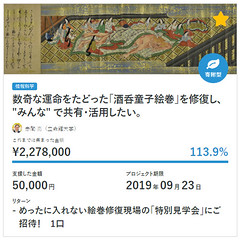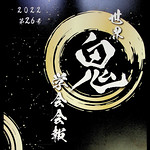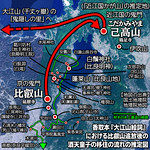What is Sanmon-Santō Sakamoto Sōezu?
Sanmon-Santō Sakamoto Sōezu (Japanese: 山門三塔坂本惣絵図) is the two old maps (1st & 2nd volume) that shows the precincts of Enryakuji Temple (Japanese: 延暦寺, Hepburn: Enryakuji) on Mount Hiei (Japanese: 比叡山, Hepburn: Hieizan) and Sakamoto area (Japanese: 坂本, Hepburn: Sakamoto) at the foot of Mount Hiei, Otsu City, Shiga Prefecture, Japan. The maps was made in 1767 [1] [2] (the middle of the Edo period [3], Japan). The author is unknown.
The 1st volume
The 1st volume of the maps shows Yokawa area (Hoku-tō area) (Japanese: 横川地区 (北塔地区), The North Pagoda area) in the precincts of Enryakuji Temple on Mount Hiei and Sakamoto area at the foot of Mount Hiei.
The 2nd volume
The 2nd volume of the maps shows Tō-dō area (Japanese: 東塔地区, The East Pagoda area) and Sai-tō area (Japanese: 西塔地区, The West Pagoda area) in the precincts of Enryakuji Temple on Mount Hiei.
Meaning of the title
The meaning of the title, Sanmon-Santō Sakamoto Sōezu (Japanese: 山門三塔坂本惣繪圖 (山門三塔坂本惣絵図)), is "the whole map of the three areas of Enryakuji Temple on Mount Hiei and the area of Sakamoto".
The meanings of the words that make up the title, Sanmon-Santō Sakamoto Sōezu, are as follows.
- The word "sanmon" (Japanese: 山門) is another name of Enryakuji Temple on Mount Hiei.
- The word "santō" (Japanese: 三塔) is a generic term used to refer to the three areas in the precincts of Enryakuji Temple: Tō-dō area (Japanese: 東塔地区, The East Pagoda area), Sai-tō area (Japanese: 西塔地区, The West Pagoda area), and Yokawa area (Hoku-tō area) (Japanese: 横川地区 (北塔地区), The North Pagoda area).
- The word "Sakamoto" (Japanese: 坂本) refers to the Sakamoto area at the eastern foot of Mount Hiei (present-day Sakamoto, Otsu City, Shiga Prefecture, Japan).
- The word "sō" (Japanese: 惣) means "whole" or "all".
- The word "ezu" (Japanese: 絵図) had used before the Meiji era (Japanese: 明治時代) to mean what we call a "map" today.
As a historical document
Enryakuji Temple is registered as a UNESCO World Heritage Site as one of the 17 temples and shrines that make up the Historic Monuments of Ancient Kyoto (Kyoto, Uji and Otsu Cities). [4] [5] [6] [7] [8] In addition, Enryakuji Temple possesses several Japanese national treasures, including Konpon-chūdō (Japanese: 根本中堂, The largest central main hall of Enryakuji Temple), and numerous Japanese important cultural properties. Therefore, Enryakuji Temple is a historically and culturally important place, and it once had possessed far more cultural properties and historical documents than are still in existence.
But the enormous cultural properties and historical documents of Enryakuji Temple suffered damage from the Siege of Mount Hiei in 1571 and much of these were lost. Currently, there are only a few historical documents that can tell us what the precincts of Enryakuji Temple in the past looked like.
Sanmon-Santō Sakamoto Sōezu is probably the most detailed pictorial old maps of the precincts of Enryakuji Temple in existence and also shows the halls of temples and shrines that may have existed before 1571. [9] Therefore, these maps are valuable historical documents to know about what the precincts in the past looked like.
Repository
Currently, these maps are one of the collections in the National Archives of Japan (NAJ). (These maps were formerly one of the collections in the Japanese Cabinet Library.)
Dimensions
- 1st volume size : Width 280cm x Height 187.5cm[9] [10]
- 2nd volume size : Width 279cm x Height 187.5cm[9] [10]
Public domain on Wikimedia Commons & article on Wikipedia
I published the image files of these maps (1st & 2nd volume) in the public domain on Wikimedia Commons as follows.
-
Wikimedia Commons (1st volume):
File:The whole map of Sanmon-Santō Sakamoto Sōezu (1st volume).png - Wikimedia Commons -
Wikimedia Commons (2nd volume):
File:The whole map of Sanmon-Santō Sakamoto Sōezu (2nd volume).png - Wikimedia Commons
I published information about them on Wikipedia (English & Japanese) as follows.
-
Wikipedia (English):
Sanmon-Santō Sakamoto Sōezu - Wikipedia -
Wikipedia (Japanese):
山門三塔坂本惣絵図 - Wikipedia
Background of my acquisition of the image files
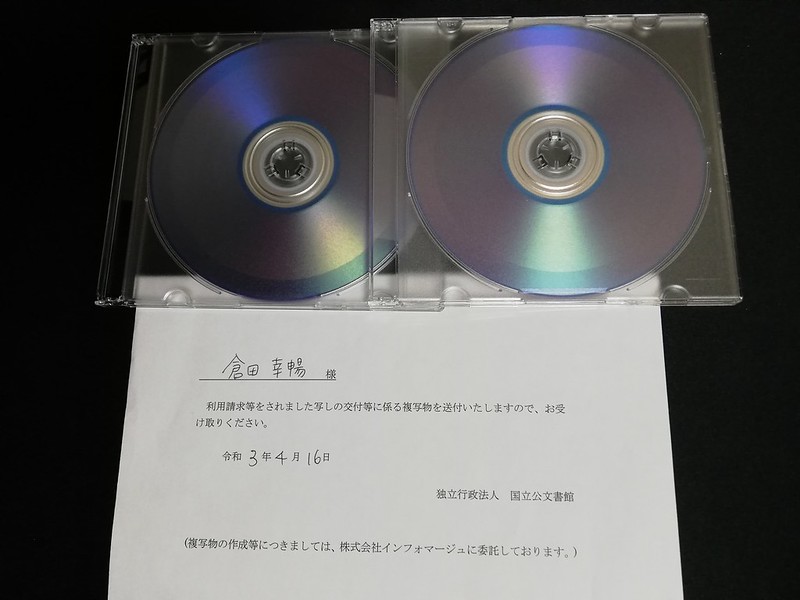
DVD-Rs containing the image files of Sanmon-Santō Sakamoto Sōezu
(I requested the National Archives of Japan to make a special copying.)
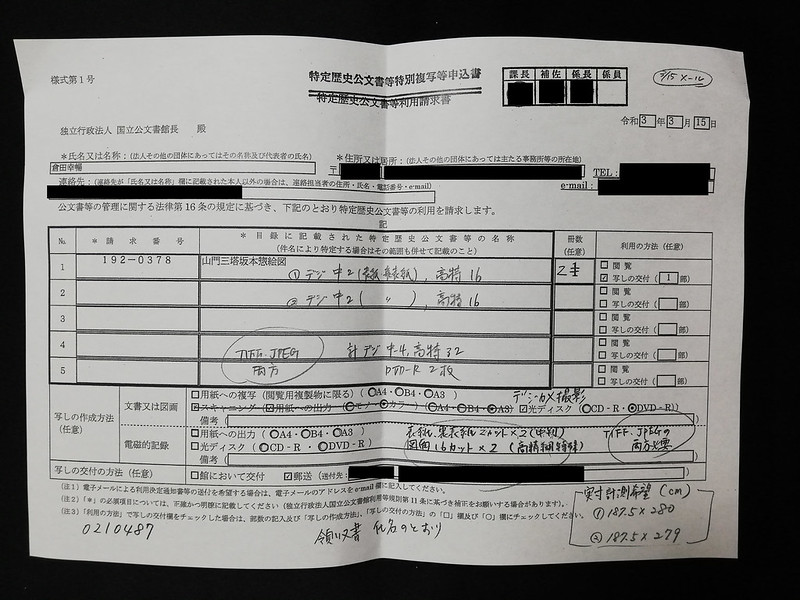
Application form for special copying of historical documents
(I submitted it to the National Archives of Japan.)
I followed the regular procedure of the National Archives of Japan (NAJ), requested the use of the digital data (image files) of the two maps, paid the following fees and other charges, and obtained the image files from NAJ, April 2021.
-
Fees for digital camera photography (medium format special photography) :
4 shots x 543 JPY/shot = 2,172 JPY -
Fees for digital camera photography (high-definition special photography) :
32 shots x 3,300 JPY/shot = 105,600 JPY -
Fees for writing of the above shooting data to DVD-R :
2 DVD-Rs x 543 JPY/disc = 1,086 JPY -
Fees for packing and shipping :
1 postal mail x 520 JPY/mail = 520 JPY -
Total fees and charges :
109,378 JPY
Each of the two maps (1st and 2nd volume) is too big to take the picture of it at one time. (The sizes of 1st and 2nd volume : Width 280cm x Height 187.5cm, Width 279cm x Height 187.5cm.) Therefore, NAJ took the pictures for each parts of them separately. Each of the two maps was divided into 16 pieces of image files. (In addition to those, NAJ took the pictures of the front cover and the back cover for each maps. Eventually the number of the image files of the two maps is 18 for each (total is 36).)
I connected these 2 x 16 pieces of image files and made 2 image files of the whole map of Sanmon-Santō Sakamoto Sōezu (1st & 2nd volume).
I publish these image files in the public domain in accordance with the terms of secondary use of digital images, etc of NAJ.
- Sanmon-Santō Sakamoto Sōezu (山門三塔坂本惣絵図) (The National Archives of Japan Digital Archive)
- Guide for Users : NATIONAL ARCHIVES OF JAPAN
- Price list for special copying (Japanese-language version : 特別複写に係る料金表(PDF))
- Price list for packing and shipping (Japanese-language version : 梱包・送料一覧(PDF))
- Secondary use of content | NATIONAL ARCHIVES OF JAPAN Digital Archive
NFTs of this post is here
Commemorative NFTs of this post are here.
Under construction.
- Reference: Take Kakuchō (Japanese: 武覚超) (2008). Hieizan shodō shi no kenkyū (Japanese: 比叡山諸堂史の研究, The Study of the History of the Halls of Enryakuji Temple on Mount Hiei). Hōzōkan (Japanese: 法藏館). p. 116. [Back ↩]
- Reference: Take Kakuchō (Japanese: 武覚超) (1992). "Naikaku Bunko zou Sanmon-Santō Sakamoto Sōezu zen niyō no seiritsu ni tsuite (Japanese: 内閣文庫蔵『山門三塔坂本惣絵図』全二葉の成立について, About the Formation of the two Maps, Sanmon-Santō Sakamoto Sōezu, in the Collection of Japanese Cabinet Library)". Eizan Gakuin kenkyū kiyō (Japanese: 叡山学院研究紀要, Bulletin of Eizan Gakuin College (Annual of Buddhist studies) ). Eizan Gakuin (Japanese: 叡山学院, Eizan Gakuin College (part of the Enryakuji Academy group) ). 15: 60–61. [Back ↩]
- Reference: Otsu City Museum of History (Japanese: 大津市歴史博物館, Hepburn: Ōtsu-shi rekishi hakubutsukan), ed. (2000). Kochizu ga kataru Ōtsu no rekishi : Kaikan 10 shūnen, bunkazai hogohō 50 nen kinen (Japanese: 古絵図が語る大津の歴史 : 開館10周年記念・文化財保護法50年記念, The History of Otsu City as Told by Old Drawings : 10th Anniversary of the Museum and 50th Anniversary of the Law for the Protection of Cultural Properties). Otsu City Museum of History (Japanese: 大津市歴史博物館, Hepburn: Ōtsu-shi rekishi hakubutsukan). p. 53. [Back ↩]
- Reference: Historic Monuments of Ancient Kyoto (Kyoto, Uji and Otsu Cities) - Maps - UNESCO World Heritage Centre. [Back ↩]
- Reference: Enryakuji Temple | Shiga Attractions | Travel Japan | JNTO (Japan National Tourism Organization). [Back ↩]
- Reference: World Heritage in Japan | Ministry of Foreign Affairs of Japan. [Back ↩]
- Reference: Sekai-isan bunkazai online (Japanese: 世界遺産 文化遺産オンライン, World Heritage Site | Japanese Cultural Heritage Online). [Back ↩]
- Reference: Kyōto-shi : Sekai-isan "Koto Kyōto no bunkazai (Kyōto-shi, Uji-shi, Ōtsu-shi)" (Japanese: 京都市:世界遺産「古都京都の文化財(京都市・宇治市・大津市)」, Kyoto City | World Heritage Site "Historic Monuments of Ancient Kyoto (Kyoto, Uji and Otsu Cities)"). [Back ↩]
- Reference: Take Kakuchō (Japanese: 武覚超) (2008). Hieizan shodō shi no kenkyū (Japanese: 比叡山諸堂史の研究, The Study of the History of the Halls of Enryakuji Temple on Mount Hiei). Hōzōkan (Japanese: 法藏館). pp. 106–107. [Back ↩]
- Note: On April 13, 2021, contacted the NAJ and confirmed the size (width and length) of the 1st and 2nd maps. [Back ↩][Back ↩]

